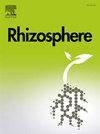内生真菌处理对不同浓度铝胁迫下蕨类植物幼苗和土壤中铝含量的影响
IF 3.4
3区 生物学
Q1 PLANT SCIENCES
引用次数: 0
摘要
虽然利用与内生真菌的相互作用是植物提高生长和抗性的一种高效且环境友好的策略,但不同内生真菌种类如何影响寄主植物在不利条件下的抗逆性仍不清楚。为了探究内生真菌对木本寄主植物抗铝性的影响,本研究将 Vernicia montana 幼苗置于不同铝浓度(T0、T1、T2、T3、T4)的环境中。在施用 Pestalotiopsis (NP)、Alternaria (LA)、Penicillium (QP)、Coniothyrium (DC) 和 Thermophilic (ST) 等内生菌悬浮液后,测定了薇甘菊幼苗根、叶和根瘤土壤中的铝含量。结果表明,铝胁迫处理、内生真菌处理及其交互作用对叶片中铝含量、根中铝含量、根瘤土壤中铝含量以及铝离子在土壤-根-叶中的迁移和滞留率均有显著影响。随着铝浓度的增加,LA 和 ST 内生菌处理的蒙大拿藤本植物叶片中铝含量增加,CK、NP 和 DC 内生菌处理的叶片中铝含量减少,QP 处理的叶片中铝含量变化不大。与 T0 相比,LA、QP、DC 和 ST 四种内生菌处理在 T4 浓度下显著降低了根部的铝含量(P < 0.05),与 NP 处理的结果相反。在 T1 浓度下,内生菌处理明显增加了 V. montana 根部的铝含量(P < 0.05)。在 T0 和 T3 浓度下,接种真菌的幼苗的叶面铝含量明显低于未接种的幼苗(P < 0.05),LRR 小于 1,而在 T2 和 T4 浓度下,则出现了相反的趋势。在相同的铝浓度下,铝迁移系数 TFsoil-root 和 TFroot-leaf 的增加比例不同。研究结果表明,内生真菌的应用改变了铝的含量以及从根瘤土壤、根到叶的迁移。内生真菌的具体作用因铝胁迫程度和真菌属而异。研究证明,接种内生真菌可以提高寄主植物的耐铝能力,从而在促进林业可持续发展方面发挥重要作用。本文章由计算机程序翻译,如有差异,请以英文原文为准。
Influence of endophytic fungi treatments on aluminum contents in Vernicia montana seedlings and soils under different concentrations of aluminum stress
Although leveraging the interaction with endophytic fungi is an efficient and environment-friendly strategy for plants to enhance growth and resistance, how different endophyte species influence host plants’ resilience in adverse conditions remain comparatively unclear. In order to explore the effect of endophytic fungi on the aluminum resistance of woody host plants, Vernicia montana seedlings were subjected to different aluminum concentrations (T0, T1, T2, T3, T4) in this study. The aluminum contents in roots, leaves and rhizospheric soil of V. montana seedlings were determined after applying endophyte suspensions of Pestalotiopsis (NP), Alternaria (LA), Penicillium (QP), Coniothyrium (DC) and Thermophilic (ST) spp. The results showed that aluminum stress treatment, endophytic fungi treatment and their interaction had significant effects on aluminum content in leaves, aluminum content in roots, aluminum content in rhizospheric soil, and the transport and retention rate of aluminum ions in soil-root-leaf. With the increase of aluminum concentrations, the aluminum content in leaves of V. montana increased in the endophyte treatments of LA and ST, decreased in CK, NP and DC, or had marginal variation in QP treatment. Compared with T0, four endophyte treatments of LA, QP, DC and ST significantly reduced root aluminum content under T4 concentration (P < 0.05), contrary to the results of NP treatment. Endophyte treatments significantly increased root aluminum content of V. montana under T1 concentration (P < 0.05). The foliar Al content in fungi-inoculated seedlings was significantly lower than that of the non-inoculated ones under T0 and T3 levels (P < 0.05), the LRR is less than 1, while the opposite trend was observed under T2 and T4 treatments. The aluminum transport coefficient TFsoil-root and TFroot-leaf increased in different proportions under the same aluminum concentration. The findings indicate that the application of endophytic fungi change the aluminum contents and transport from rhizospheric soil, roots to leaves. The specific effects of endophytic fungi vary with the degree of aluminum stress and the fungi genus. The study proves that inoculation of endophytic fungi can improve the aluminum tolerance of host plants, and thereby play an important role in promoting the sustainable development of forestry.
求助全文
通过发布文献求助,成功后即可免费获取论文全文。
去求助
来源期刊

Rhizosphere
Agricultural and Biological Sciences-Agronomy and Crop Science
CiteScore
5.70
自引率
8.10%
发文量
155
审稿时长
29 days
期刊介绍:
Rhizosphere aims to advance the frontier of our understanding of plant-soil interactions. Rhizosphere is a multidisciplinary journal that publishes research on the interactions between plant roots, soil organisms, nutrients, and water. Except carbon fixation by photosynthesis, plants obtain all other elements primarily from soil through roots.
We are beginning to understand how communications at the rhizosphere, with soil organisms and other plant species, affect root exudates and nutrient uptake. This rapidly evolving subject utilizes molecular biology and genomic tools, food web or community structure manipulations, high performance liquid chromatography, isotopic analysis, diverse spectroscopic analytics, tomography and other microscopy, complex statistical and modeling tools.
 求助内容:
求助内容: 应助结果提醒方式:
应助结果提醒方式:


